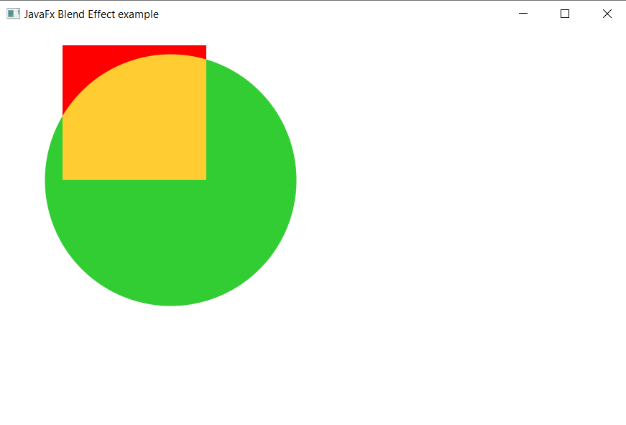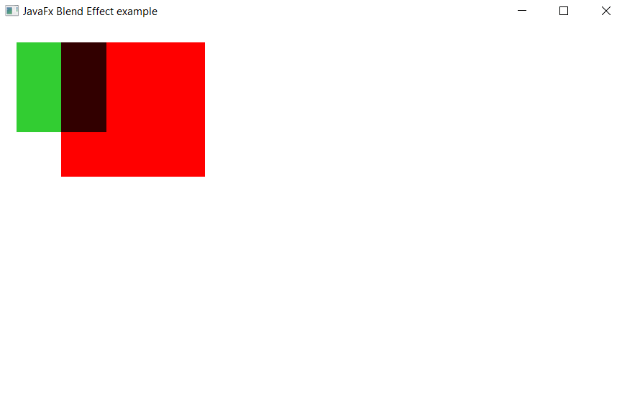JavaFX Blend
In the JavaFX application, in order to apply various blend effect, we use Blend class. It has the ability to blend the colors of the shape. All methods needed for this purpose are present in the javafx.scene.effect.Blend class.
Properties and corresponding methods to create Blend Effect :
1. mode
This property is of BlendMode type. It is used to represent the mode according to which blending is applied and the setMode( BlendMode value ) method is used to set it.
2. topInput
This property is of Effect type. It is used to represent the top input required for performing the blend operation and the setTopInput( Effect value) method is used to set it.
3. bottonInput
This property is of object type. It is used to represent the bottom input required for performing the blend operation and the setBottomInput( Effect value ) method is used to set it.
4. Opacity
This property is of double type. It is used to represent the opacity value for the blend operation and the setOpacity( double value ) method is used to set it.
JavaFX Effect – Blend
Example:
import javafx.application.Application;
import javafx.scene.Group;
import javafx.scene.Scene;
import javafx.scene.effect.Blend;
import javafx.scene.effect.BlendMode;
import javafx.scene.effect.ColorInput;
import javafx.scene.paint.Color;
import javafx.scene.shape.Circle;
import javafx.stage.Stage;
public class EffectUI extends Application {
@Override
public void start(Stage stage) throws Exception
{
Circle circle = new Circle(190,170,140);
circle.setFill(Color.LIMEGREEN);
Blend blend = new Blend();
ColorInput color = new ColorInput(70, 20, 160, 150, Color.RED);
blend.setTopInput(color);
blend.setMode(BlendMode.ADD);
circle.setEffect(blend);
Group root = new Group(circle);
Scene scene = new Scene(root,700,450);
stage.setScene(scene);
stage.setTitle("JavaFx Blend Effect example");
stage.show();
}
public static void main(String[] args) {
launch(args);
}
}
Output:
In order to create Blend Effect in JavaFX, we have to import all the required libraries such as javafx.application.Application, javafx.scene.Group, javafx.scene.Scene, javafx.scene.effect.ColorInput, javafx.scene.paint.Color, javafx.scene.shape.Rectangle, javafx.scene.effect.BlendMode, javafx.scene.image.Blend, javafx.stage.Stage.
Then we have created one class named EffectUI extending the Application class. Also, we have to override the start method to provide implementation details. This method creates an object of Stage as primaryStage. For the container to hold a circle and rectangle with two different color having the blend effect, a Group object is created which is then passed to the Scene class object.
The circle is created using the constructor having size parameter passed to it. The limegreen is filled in the circle. The blend constructor is created. Using color input constructor the red color with size parameter forms a rectangle which specifies the blend effect on a circle. The blend mode is set to add which adds the two color and form the new color as the blend effect.
The stage is prepared, the title is set and the show() method is called to display output. In order to run the application, the launch(args) method is called in the main() method. In output Frame like container is displayed with the title, " JavaFX Blend Effect example”. Also, it displays the circle and the rectangle with limegreen and red color and blend effect with yellow color.

JavaFX Effect – Blend Darken mode Example :
Example:
import javafx.application.Application;
import javafx.scene.Group;
import javafx.scene.Scene;
import javafx.scene.effect.Blend;
import javafx.scene.effect.BlendMode;
import javafx.scene.effect.ColorInput;
import javafx.scene.paint.Color;
import javafx.scene.shape.Circle;
import javafx.scene.shape.Rectangle;
import javafx.stage.Stage;
public class EffectUI extends Application {
@Override
public void start(Stage stage) throws Exception
{
Rectangle rect=new Rectangle();
rect.setX(20);
rect.setY(20);
rect.setWidth(100);
rect.setHeight(100);
rect.setFill(Color.LIMEGREEN);
Blend blend = new Blend();
ColorInput color = new ColorInput(70, 20, 160, 150, Color.RED);
blend.setTopInput(color);
blend.setMode(BlendMode.DARKEN);
rect.setEffect(blend);
Group root = new Group(rect);
Scene scene = new Scene(root,700,450);
stage.setScene(scene);
stage.setTitle("JavaFx Blend Effect example");
stage.show();
}
public static void main(String[] args) {
launch(args);
}
}
Output:
In order to create Darken Blend Effect in JavaFX, we have to import all the required libraries such as javafx.application.Application, javafx.scene.Group, javafx.scene.Scene, javafx.scene.effect.ColorInput, javafx.scene.paint.Color, javafx.scene.shape.Rectangle, javafx.scene.effect.BlendMode, javafx.scene.image.Blend, javafx.stage.Stage.
Then we have created one class named EffectUI extending the Application class. Also, we have to override the start method to provide implementation details. This method creates an object of Stage as primaryStage. For the container to hold two rectangle with two different color having the darken blend effect, a Group object is created which is then passed to the Scene class object.
The rectangle is created using the constructor having size parameter passed to it. The limegreen is filled in the rectangle. The blend constructor is created. Using color input constructor the red color with size parameter forms a rectangle and blend effect set to darken produces darken color as a blend effect.
The stage is prepared, the title is set and the show() method is called to display output. In order to run the application, the launch(args) method is called in the main() method. In output Frame like container is displayed with the title, " JavaFX Blend Effect example”. Also, it displays two rectangle with limegreen and red color respectively and darken blend effect with black color.
